Born in Taverna, a small village in the Sila Mountains, Mattia Preti (Taverna, 1613 - Valletta, 1699) was one of the greatest artists of the seventeenth century, and his success also earned him a knighthood in Malta, so much so that he was nicknamed “the Cavalier Calabrese.” his long career, from his beginnings in Rome together with his brother Gregory and marked by an interest in both Caravaggesque and Bolognese painters (with trips to northern Italy thanks to which Mattia Preti came into contact with Venetian art), was a crescendo of successes that finally led him to Malta, where the artist spent the last part of his existence. Mattia Preti was a very prolific artist and left behind a large body of works, now preserved in several museums around the world.
Preti started from afar: Taverna, now in the province of Catanzaro, was a village certainly far from the most up-to-date centers, although the artist could admire in his hometown works by rather interesting artists such as Giovanni Bernardo Azzolino (Cefalù, 1598 - Naples, 1645), a Sicilian painter active in the late 16th and early 17th centuries, who was asked to paint some paintings for a local church, and who proposed a devout and Counter-Reformation art but with marked naturalistic hints. To Azzolino’s name, the most important, should be added that of Giovanni Balducci (Florence, 1560 - Naples, after 1631), a Florentine painter whose work was recorded in the town, but despite this there was no major painter who was actually active in the Calabrian town, thus Mattia Preti’s training elsewhere. The painter came from a family of the local petty nobility, and this background facilitated his training, as he was able to afford to study and travel: he is thus found very young in 1630 in Rome, where he had joined his brother Gregorio, who was ten years his senior and also a painter(read the review on the exhibition that delved into the relationship between Gregorio and Mattia Preti).
However, in seventeenth-century Rome the main name of reference was that of Caravaggio, declined of course according to the meanings of the Caravaggesque painters, in particular Bartolomeo Manfredi: these were the first models that inspired Mattia Preti. But his training did not take place only in Rome, for the artist from Calabria also traveled to northern Italy: he was in Venice where he met Titian Vecellio, Paolo Veronese and Tintoretto, he stayed in Emilia where he came into contact with the art of painters such as the Carraccis, Domenichino and Guercino, and sources also speak of a trip to France that took place after 1640: Mattia Preti was thus an artist who had a vast number of influences that influenced his art over time. He is widely remembered as one of the most important artists of the seventeenth century, among the greatest in the South, for his originality, for the quality of his works, for the fact that he was a very prolific and in-demand artist, for the fact that he knew how to combine different influences with each other in his paintings without excess and with great skill, for his great openness to different sources of inspiration that made his art never constant over time. His experience was important for many artists who were inspired by him, such as Luca Giordano, who not only gave Mattia Preti some inspiration but was himself inspired by the artist: artists such as Francesco Solimena, Bernardino Mei, Tommaso Giaquinto, Ferrante Amendola, and other artists active mainly in the south then looked to Mattia Preti.
 |
| Mattia Preti, Self-portrait, detail of the Preaching of the Baptist (c. 1684; oil on canvas, Taverna, San Domenico) |
Mattia Preti was born on February 24, 1613, in Taverna, a small town in the Sila Mountains today in the province of Catanzaro, to Cesare Preti and Innocenza Schipani, who belonged to the local petty nobility. Around 1630, he moved to Rome to study with his older brother Gregorio, also a painter. He became fascinated by the painting of the Caravaggesque painters (in particular Bartolomeo Manfredi, whose Manfrediana methodus, a pictorial genre that focused on depicting scenes of humble daily life, would inspire some of Mattia’s works) and that of the Bolognese artists. At the same time he made trips to northern Italy, where he not only delved into Emilian painting but also came into contact with Venetian painting. He probably also makes a trip to France. Around the same year he also painted the Escape of Aeneas from Troy, one of his earliest works. About 1640 he returned to Rome following his study trips. In 1642 he became a knight of Malta (hence the nickname “il Cavalier Calabrese”) and in about 1645 he was in Genoa, where he worked for some of the local noble families and painted masterpieces such as Clorinda libera Sofronia and Olindo dal rogo and the Resurrezione di Lazzaro, both of which are preserved in the Ligurian city.
In 1650, after the death of Giovanni Lanfranco (Parma, 1582 - Rome, 1647), Cardinal Francesco Peretti commissioned Mattia to paint the frescoes for the choir of the Roman church of Sant’Andrea della Valle on the occasion of the jubilee: Mattia asked Pietro da Cortona (Pietro Berrettini; Cortona, 1596 - Rome, 1669) for advice, but the work proved to be a failure and the consolations of his friends were to no avail. It is nevertheless one of his most interesting works as the only example in his art of Cortonism (i.e., a style close to that of Pietro da Cortona). In 1653, the artist moved to Naples, probably, as his biographer Bernardo De Dominici relates, after injuring a rival in a fencing duel (Mattia Preti was also an excellent fencer).
A few years later, in 1656, the artist executed the Return of the Prodigal Son, now preserved at the National Museum of Capodimonte in Naples. In the same year he began making votive paintings on the city gates to ward off the plague. Apparently Mattia made the frescoes for free because he was sentenced to death after killing a guard who did not want him to enter the city when he arrived, but because he was a distinguished personage, his sentence was commuted. In 1661 the artist made another brief stay in Rome, but then moved to Malta, where he settled permanently, becoming official painter of the Order of the Knights of Malta. In the same year he began his first Maltese venture, the decoration of the Cathedral of St. John the Baptist, completed in 1666. In about 1672 he began making a number of paintings for his hometown, Taverna: he would make several later on as well. In 1678 he painted St. George for the Basilica of St. George in Gozo. Around the same year he produced works for churches in Floriana, while in 1683 he executed some works for the Oratory of the Beheading in Valletta(read more about these paintings here). He continued to work for Malta but also for commissions outside the island (he painted paintings in Malta that he then sent elsewhere) until his death on January 3, 1699 in Valletta.
 |
| Gregorio and Mattia Preti, Concerto con scena di buona ventura (1630-1635; oil on canvas, 195 x 285 cm; Turin, Pinacoteca dell’Accademia Albertina) |
 |
| Mattia Preti, Dame’s Game (c. 1630-1640; oil on canvas, 109 x 144 cm; Oxford, Ashmolean Museum) |
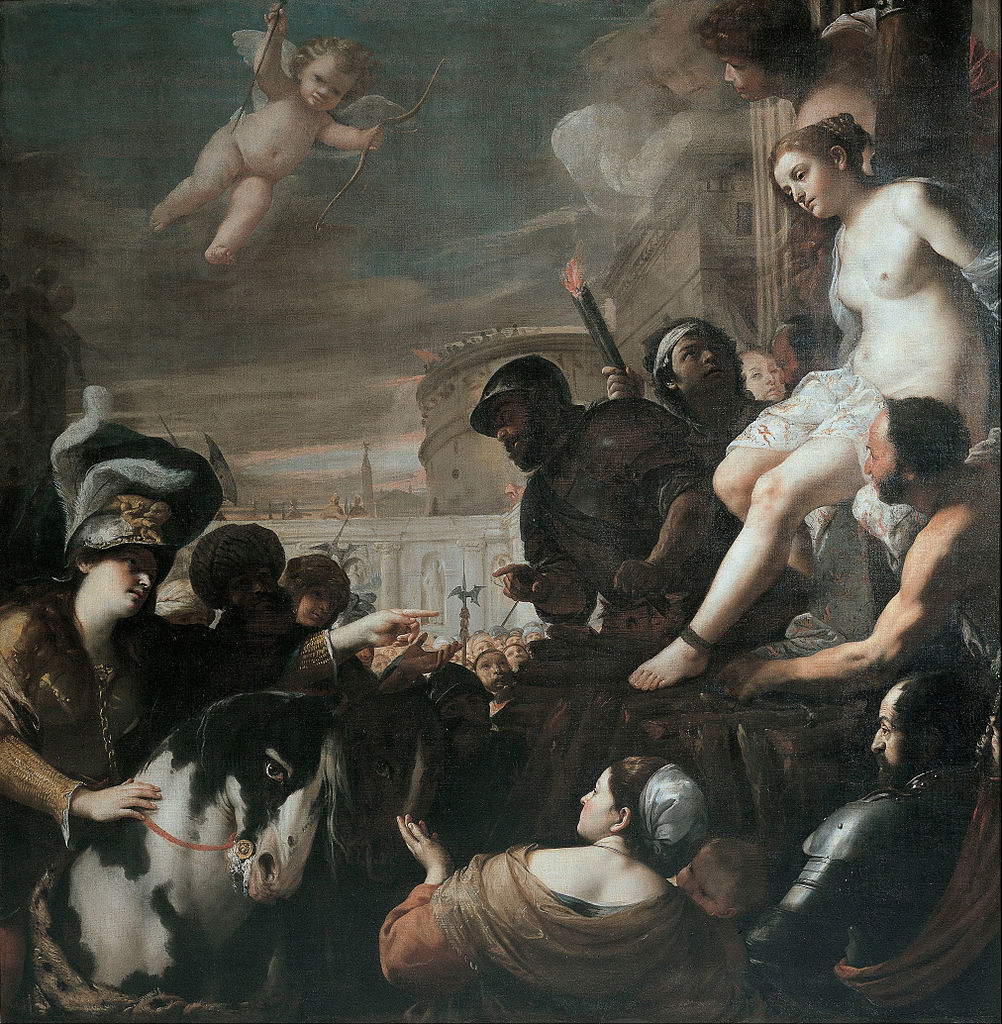 |
| Mattia Preti, Clorinda frees Olindo and Sofronia from the stake (c. 1646; oil on canvas, 248 x 245 cm; Genoa, Musei di Strada Nuova, Palazzo Rosso) |
Mattia Preti was able to reflect on Caravaggio ’s painting through the Caravaggesque painters, particularly through Bartolomeo Manfredi, so much so that many of Mattia Preti’s early paintings closely reflect the so-called “manfrediana methodus” that is, the typical manner of Bartolomeo Manfredi, who proposed a Caravaggism very close to Michelangelo Merisi (humble subjects, gloomy atmospheres, vivid naturalism), but with much less dramatic tones, preferring genre scenes that had no allegorical or devotional purpose. With Bartolomeo Manfredi, Caravaggio’s light was stripped of its symbolic charge, and this way of painting achieved great success at the time, so that there were many painters who followed the Manfredi methodus. Thus in the early part of Mattia Preti’s production we often find genre scenes, characterized by great naturalism, as can also be seen in the works he produced with his brother.
Later works, such as Clorinda frees Sofronia and Olindo from the dragon and the Resurrection of Lazarus both preserved in the Palazzo Rosso in Genoa, on the other hand, register new trends in Mattia Preti’s art: one thus finds neovenetian atmospheres that are especially recognizable in the chromatism and in the way the sky is painted, a reflection on the Bolognese classicism of the time evident if one looks at the “positive” characters, who are distinguished by their almost ethereal beauty, while the torturers, the soldiers, King Aladdin himself, are all strongly characterized, painted in a naturalistic, Caravaggesque manner. In addition to these elements, if one looks at the Resurrection of Lazarus in particular, one can also see an approximation to Luca Cambiaso’s manner, especially with regard to the use of light: the body of Lazarus is in fact completely illuminated, although there do not seem to be any sources of light coming from that area of the painting (indeed, it seems that it is Jesus himself who illuminates him: thus, as in Luca Cambiaso, one notices a light that is more intellectual and mystical than real, as was the case in Caravaggio’s paintings). The body of Lazarus still has vivid naturalistic and Caravaggesque hints and is contrasted with that of Jesus, which is instead very classical: these are therefore very original and intense compositions in which Mattia Preti synthesizes with great skill all the most up-to-date instances of the painting of his time.
Also very interesting are the works of the Neapolitan period (such as the Return of the Prodigal Son in the National Museum of Capodimonte) where Caravaggism returns preponderantly (this can be seen in the way the faces, bodies, and expressions of the characters are depicted, in the high degree of naturalism of the composition, and in the atmosphere) but where important Guercino influences still remain, which can be seen in the use of colors in the broad composition, and in the theatricality of the compositions (in the Capodimonte work the theatricality is suggested not only by the breadth of the composition and the arrangement of the characters but also by the gestures, such as those of the protagonists who are dressing the prodigal son who has just returned after his vicissitudes). In Naples, Mattia Preti had returned to a Caravaggesque style of painting precisely because the major Neapolitan painters of the time (such as Massimo Stanzione, Bernardo Cavallino, and José de Ribera) were referring directly to Caravaggio. As a result, a theatrical and monumental Caravaggism enters Mattia Preti’s art, which can also be seen in the Resurrection of Lazarus that is in the Galleria Nazionale d’Arte Antica in Palazzo Barberini in Rome, dating from between 1656 and 1660. There are strong hints of naturalism, there is a slanting light coming from the upper right corner although it is not possible to identify the source and it does not look like natural light either, and the theatricality typical of this period returns.
One of the largest chapters of Mattia Preti’s story is the one related to Malta: the artist arrived on the island in 1661 probably attracted by the possibility of obtaining commissions from the Order of the Knights of Malta (Mattia Preti had already obtained a knighthood in 1642). And indeed, his activity in Malta was very fervent, so much so that he stayed on the island for the rest of his life, that is, for almost forty years, although there was no lack of brief sojourns in Italy, however. One of the first commissions he obtained in Malta was the decoration of the Co-Cathedral of St. John the Baptist in Valletta, where he executed a number of magnificent paintings, although he did not use the fresco technique, but instead applied an oil-based preparation to the walls: the paintings decorating the vault are especially noteworthy, in the overall undertaking that Mattia Preti began in 1661 and finished in 1666. The vault is decorated with the stories of Saint John the Baptist: it is a large barrel vault divided into six sections punctuated by arcades, and each section has three episodes for a total of eighteen stories. Here, Mattia Preti seems to have reflected on his Sant’Andrea della Valle frescoes, for the great luminosity and clear coloring that these Maltese paintings emanate recalls that of his earlier decorative work, but this time the proportions of the figures are better calibrated and go more in line with Bolognese classicism, of Carraccian inspiration but also looking to Domenichino, which was part of Mattia Preti’s cultural background. The artist here proposes a very airy painting where gold and blue tones prevail, in line with the Baroque taste of the time, probably also in the light of a reflection on the rising star Luca Giordano, who would shortly thereafter become one of the main points of reference of the great Baroque decoration. Curiously, Mattia Preti received a fee for these achievements that could be considered inadequate, in that it was far less than a fee that could be earned for the same work in Rome or Naples, but the painter was not particularly attracted to money (indeed, he apparently donated much of his earnings to charity). Mattia Preti painted hundreds of works in Malta, so it is not easy to choose a representative one: the Valletta Cathedral paintings represent the first phase of his Maltese activity, with the artist making the brightness and airiness of Baroque painting his own, but in the later phase his palette would become narrower and the atmospheres would return to a more somber mood. An example here is the St. George found in the Basilica of St. George in Gozo (1678). The saint is in a classical pose, just as classical is his armor, next to his horse, and rests his foot on the terrible dragon that has always accompanied depictions of the saint, while on the left we observe a young woman, depicted in the act of praying (an allegory of faith, dressed in the traditional dress of the peasants of the island of Gozo). It is a painting of symbolic value, representing good triumphing over evil, a solemn, celebratory painting that exemplifies the latter part of Mattia Preti’s career.
 |
| Detail of the frescoes in Sant’Andrea della Valle |
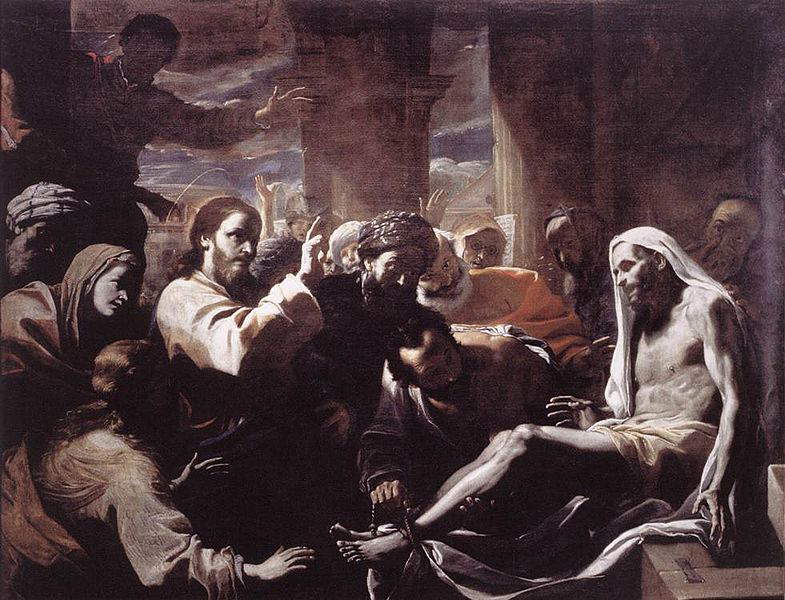 |
| Mattia Preti, Resurrection of Lazarus (1650-1659; oil on canvas, 202 x 260 cm; Rome, Galleria Nazionale d’Arte Antica di Palazzo Barberini) |
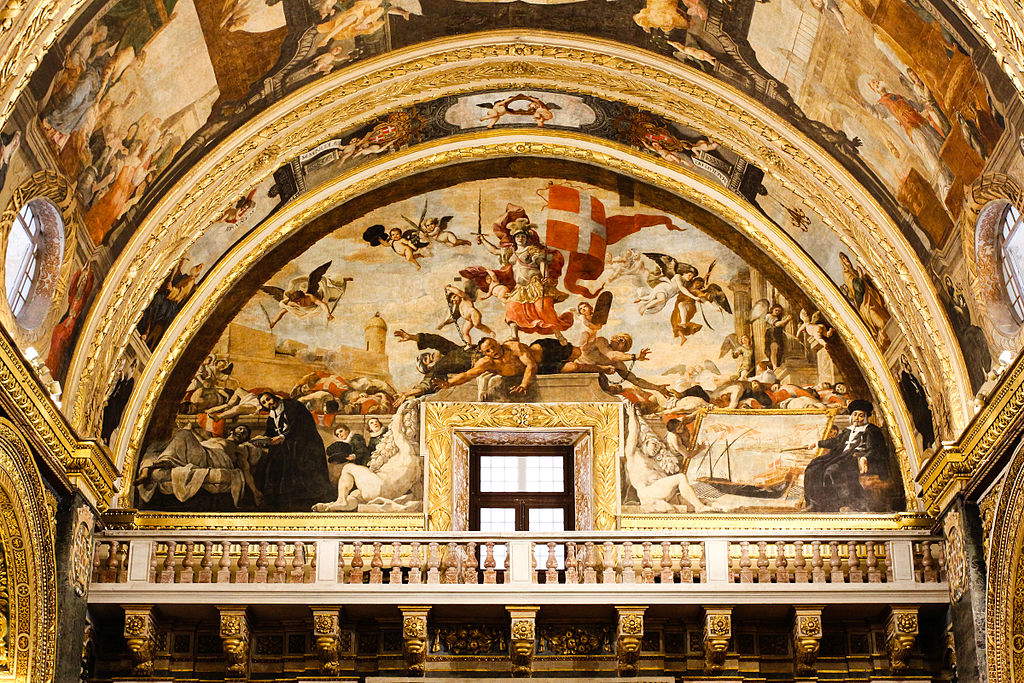 |
| Mattia Preti, Triumph of the Order of St. John (1662; oil on wall; Valletta, Co-cathedral of St. John) |
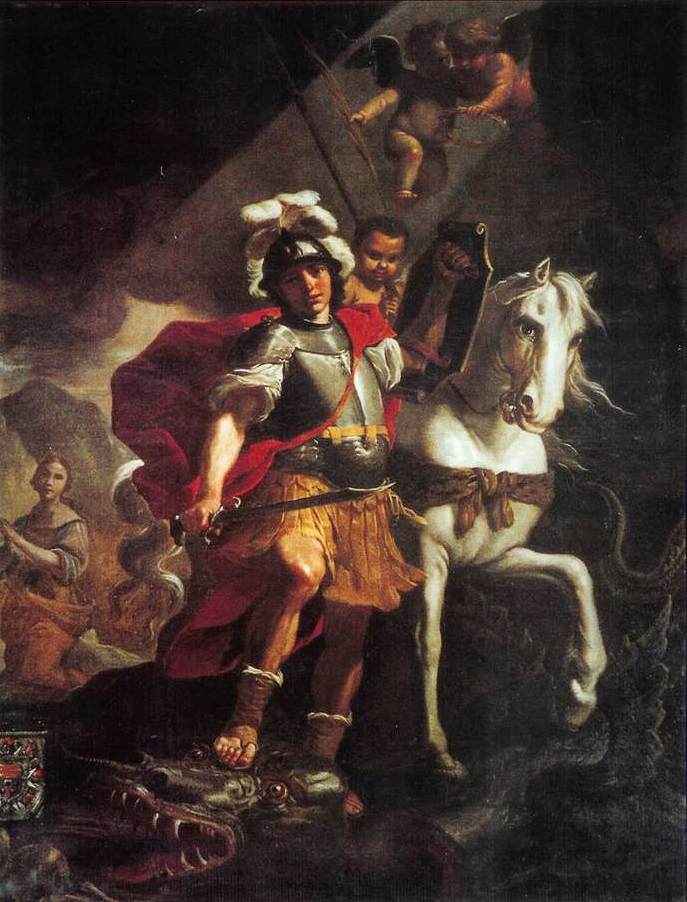 |
| Mattia Preti, St. George and the Dragon (1678; oil on canvas; Victoria, St. George’s) |
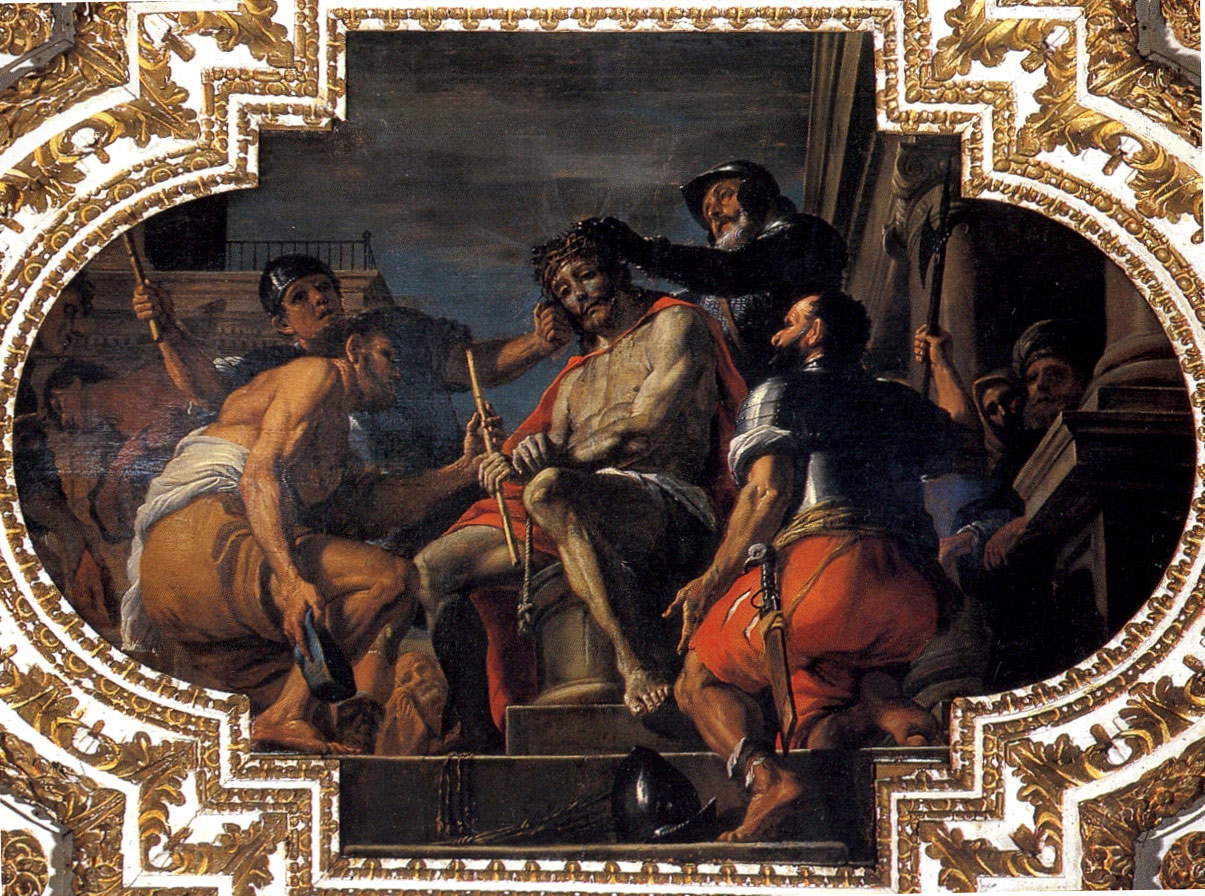 |
| Mattia Preti, Christ Crowned with Thorns (1679-1689; oil on canvas, 227 x 350 cm; Valletta, Oratory of St. John Decollate) |
Mattia Preti was a very prolific artist therefore his works can be found in various museums, churches and historic buildings around the world. Even his hometown, Taverna, preserves his works(read more about it here): you can find his paintings in the Museo Civico di Taverna, in the church of San Domenico (which preserves one of his important cycles) and in the church of Santa Barbara. Masterpieces by Mattia Preti can be found in Rome, especially at the Galleria Nazionale d’Arte Antica in Palazzo Barberini, which holds several of his important paintings, but a visit to the church of Sant’Andrea della Valle to see his frescoes is also a must. Works by Mattia Preti can also be found at the Museo di Palazzo Rosso in Genoa ( Clorinda libera Sofronia e Olindo dal rogo and the Resurrezione di Lazzaro, two of his major masterpieces, are particularly admired there) and also in Genoa, at the Galleria Nazionale di Palazzo Spinola. Another city where Mattia Preti has a strong presence is Naples: several of his works are housed at the National Museum of Capodimonte (the Judith and Holofernes, the Saint John the Baptist, theImmaculate Conception and several others), and other works of his can be seen at the Basilica of San Lorenzo Maggiore, in the church of San Pietro a Majella, at the Royal Palace, and at the Museo Civico di Castel Nuovo.
Then again, the Uffizi in Florence, the Pinacoteca Nazionale in Bologna, the Galleria Regionale di Palazzo Abatellis in Palermo, the Museo Regionale di Messina, the Museo Nazionale dell’Abruzzo in L’Aquila, and the Museo Civico di Carpi. Abroad, many of the major foreign museums that hold works of ancient art usually also have works by Mattia Preti: it will suffice to mention the Hermitage in St. Petersburg, the Kunsthistorisches Museum in Vienna, the Prado, the National Gallery in London, the Getty in Los Angeles, the Metropolitan Museum in New York, the Museo de Bellas Artes in Seville, and the Ringling Art Museum in Sarasota, Florida. But if one wants to see Mattia Preti’s works placed in their contexts, it is worth traveling to Malta to see the churches, palaces, and museums in all locations on the island: the capital city Valletta (especially the Co-Cathedral of St. John) and cities such as Sliema, Floriana, Rabat, Mdina, Zurrieq, Vittoriosa, Lija, and Luqa.
 |
| Mattia Preti, the life and major works of the Cavalier Calabrese |
Warning: the translation into English of the original Italian article was created using automatic tools. We undertake to review all articles, but we do not guarantee the total absence of inaccuracies in the translation due to the program. You can find the original by clicking on the ITA button. If you find any mistake,please contact us.